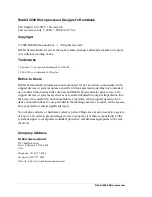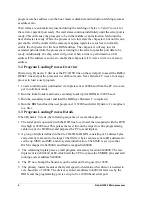
10
Rabbit
2000
Microprocessor
this
degree of control is not desired for a particular situation, then certain pins can be
left
unconnected in the connecting cable, limiting the functionality of the connector to
serial
communications. Z-World will be developing products and software that assume
the
presence of the programming connector.
•
Dynamic
C and a PC are not necessarily needed for the production programming of
flash
memory since the flash memory can be copied from one controller to another by
cloning.
This is done by connecting the system to be programmed to the same type of
system
that is already programmed by means of a cloning cable. The cloning cable con-
nects
to both programming ports and has a button to start the transfer of program and an
LED
to display the progress of the transfer.
Dynamic
C programming uses the Rabbit’s serial port A for software development. How-
ever,
it is still possible, with some restrictions, for the user’s application to also use port A.
4.1
Memory Organization
The
Rabbit architecture is derived from that of the original Z80 microprocessor. The orig-
inal
Z80 instruction set used 16-bit addresses to address a 64K memory space. All code
and
data had to fit in this 64K space. The Rabbit adopts a scheme similar to that used by
the
Z180 to expand the available memory space. The 64K space is divided into zones and
a
memory mapping unit or MMU maps each zone to a block in a larger memory; the larger
memory
is 1 megabyte in the case of the Z180 or the Rabbit 2000. The zones are effec-
tively
windows to the larger memory. The view from the window can be adjusted so that
the
window points to different blocks in the larger memory. Figure 2 on page 12 shows the
memory
mapping schematically.
The
Rabbit has a basic 20-bit or 1-megabyte physical memory space. In special circum-
stances
more than 1-megabyte of memory can be installed and accessed using auxiliary
memory
mapping schemes. Typical Rabbit systems have two types of physical memory—
flash
memory and static RAM memory. Flash memory follows a write once in a while and
read
frequently model. Depending on the particular type of flash used, the flash memory
will
wear out after it has been written around 10,000 to 100,000 times.
Rabbit
flash memory may be small-sector type or large-sector type. Small-sector memory
typically
has sectors of 128 or 256 bytes. Individual sectors may be separately erased and
written.
In large-sector memory the sectors are often 16K or 64K or more. Small-sector
memory
provides better support for program development and debugging, and large-sec-
tor
memory is less expensive and has faster access time. The best solution will usually to
lay
out a design to accept several different types of flash memory, including the flexible
small-sector
memories and the fast large-sector memories. At the present time develop-
ment
support for programs tested in flash memory is confined to flash memories with sec-
tors
of 256 bytes or 128 bytes. If larger sectors are used, the code must be debugged in
RAM
and then loaded to flash for a final test that does not involve setting break points. In
future
releases it is planned to support direct debugging in large-sector flash. Large-sector
flash
is desirable for the better access time and power consumption specifications that are
available.
Summary of Contents for 2000
Page 1: ...Rabbit 2000 Microprocessor Designers Handbook Revision C...
Page 4: ...Rabbit 2000 Microprocessor...
Page 6: ...2 Rabbit 2000 Microprocesssor...
Page 12: ...8 Rabbit 2000 Microprocessor...
Page 34: ...344 Dynamic C User s Manual...
Page 36: ...34 Rabbit 2000 Microprocessor...
Page 44: ...42 Rabbit 2000 Microprocessor...















































